Reflections on the effectiveness of Japanese mid-caliber artillery in Tsushima
Let's try to understand this issue.
Unfortunately, we do not have at our disposal, and (before the creation of the time machine) there will not be any accurate data on how many and what projectiles (armor-piercing, high-explosive) got into the Russian ships in Tsushima. There are contradictory data even for the Eagle that survived the battle, what can be said about the three dead Russian battleships of the Borodino type ... However, it can be assumed that, having studied the effectiveness of the fire in other battles of the Russian-Japanese war, we will see some interrelations trends and we can draw conclusions that will help us to understand what happened in Tsushima.
So, without claiming the absolute accuracy of the data, but realizing that minor errors do not change the overall result, let's try to compare the number of shells of the Japanese and Russian squadrons in 27 January 1904 g, as well as in the Battle of Shantung (battle in the Yellow Sea) held on July 28 1904 with the number of hits that Russian and Japanese gunners could achieve. Let's start with the January 27 battlefield.
The consumption of shells of the Japanese squadron (hereinafter the data from the series of articles by V. Maltsev “On the issue of shooting accuracy in the Russo-Japanese war” are used) was 79 - 305-mm; 209 -203-mm; 922 - 152-mm, also 132-120-mm and 335 75-mm, but we will ignore the latter, as we consider hits of projectiles from 152-mm and above.
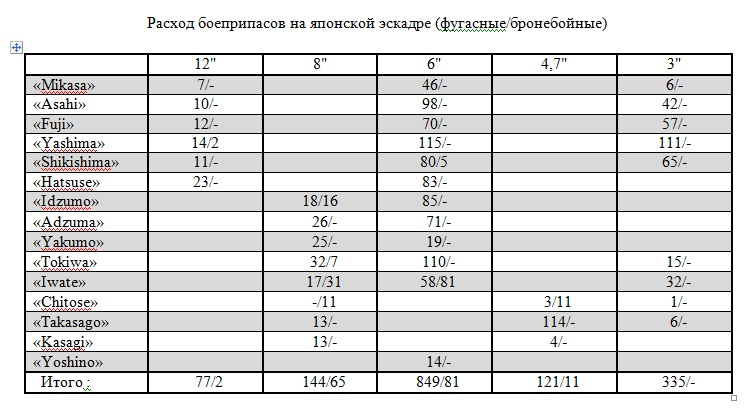
It is known that the ships of the Russian squadron got 8 - 305-mm shells, 5-203-mm, 8 - 152-mm and nine more shells 152-203 mm, the exact caliber of which, alas, was not determined, 6-75 mm and one xnumx-mm. Thus, the percentage of hits for different calibers was:
For 305 shells, 10,13%;
For 203-mm projectiles - not lower than 2,39%, and possibly even higher (up to 6,7%, depending on how many of the nine projectiles of an unspecified 152-203-mm caliber actually were 203-mm);
For 152-mm projectiles - not lower than 0,86%, and possibly even higher (up to 1,84%, depending on how many of the nine projectiles of an unspecified 152-203-mm caliber were actually 203-mm).
As you can see, the scatter of the values turned out to be very large, and does not make it possible to judge the accuracy of shooting 152-mm and 203-mm calibers separately. But we can do a general calculation for six- and eight-inch caliber projectiles - the Japanese have spent 1 131 such projectiles in total and achieved 22 hits. In this case, our comparison of the percentage of hits takes the form:
For 305 shells, 10,13%;
For shells caliber 152-203-mm - 1,95%.
Thus, we see that the accuracy of the Japanese 305-mm artillery exceeded that of the 152-203-mm guns 5,19 times. But due to the fact that the number of shells fired by six- and eight-inch cannons significantly exceeded the amount of 305-mm ammunition consumed (1131 versus 79, i.e. 14,32 times), 305-hits of 2,75 hits fell on one hit -152-mm.
Let us now look at the figures that the Russian squadron achieved in the 27 battle in January 1904.
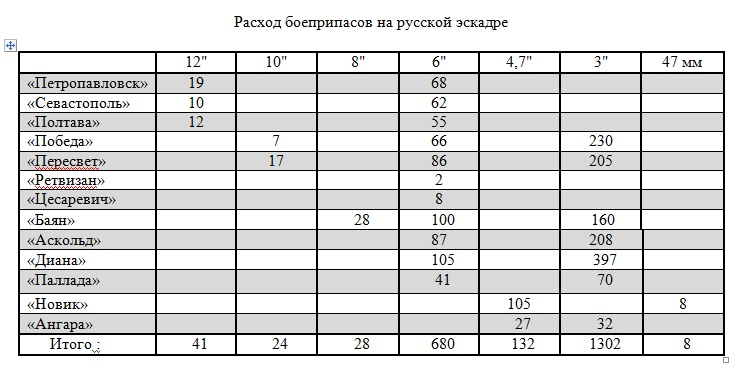
At the same time the Japanese ships hit 3- 305-mm projectile, 1-254-mm, 2 - undetermined caliber mm 254-305, 1-203-mm, 8- 152-mm, 4 -120-mm and 6-75- mm
As we see, the situation has changed to the exact opposite - here we reliably know the number of hits of medium-caliber projectiles, but with large-caliber ones - the problem. Therefore, we present the calculation of the percentage of hits as follows:
For large-caliber shells (254-305-mm) - 9,23%;
For medium caliber shells (152-203-mm) - 1,27%, including:
For shells caliber 203-mm - 3,57%;
For shells caliber 152-mm - 1,18%.
Thus, we again see a big difference in the accuracy of large and medium caliber artillery. In the 27 battle of January, the Russian ten- and twelve-inch shots shot out more precisely 7,26 times, but given the fact that 152-203-mm shells were fired far more than 254-305-mm (708 versus 65), then 254-305 mm -mm projectile had a half hit caliber 152-203-mm.
Thus, we see an interesting trend - the fire of medium-caliber artillery is much less accurate than large-caliber artillery. But on the other hand, six- and eight-inch guns in battle manage to spend many times more projectiles than heavy guns, so the number of hits of 152-203-mm projectiles is still higher. There is no doubt that the difference in the number of hits is significant, but nevertheless the large and medium caliber artillery does not differ tenfold in this parameter - we can see that the Russians hit 1,5 for one heavy projectile, and 2,75 for the Japanese for medium caliber ones.
Let's see now the results of the battle at Shantung 28 July 1904.
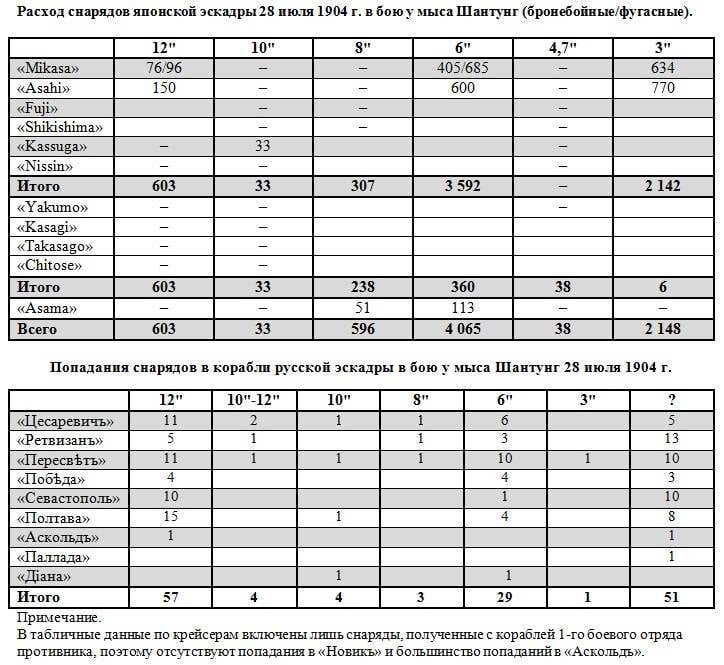
As we can see in the table, there is already an 51 “unspecified” hit, which does not allow for analysis in the context of each caliber. Nevertheless, it will not be a big mistake to assume that the vast majority of them belong to 152-203-mm projectiles, therefore for our calculation we will assign them all to the hits of average caliber artillery. In this case, the percentage of hits will look like:
For shells caliber 254-305-mm - 10,22%;
For shells, caliber 152-203-mm - 1,78%.
Thus, we see that the accuracy of the Japanese shooting has no fundamental changes in comparison with the January 27 battle. In the battle in the Yellow Sea, the 254-305-mm guns showed accuracy that was 5,74 times higher than the average caliber artillery. At the same time, the Japanese achieved 65 hits with 254-305-mm caliber and only 83 hits with 152-203 mm caliber, that is, one 254-305-mm projectile hit the target had only 1,28 hits of six- and eight-inch shells. And it should be understood that 83-152-mm projectiles 203 hits are the maximum possible figure, assuming that at least a few of the 51 hits of unknown caliber fell on large-caliber or vice versa, small-caliber artillery, this ratio will be even lower. As we can see, the accuracy of firing of medium-caliber artillery decreased slightly. Why did such a fall occur in the ratio of hits of large-caliber and medium-caliber artillery - from 2,75 to medium-caliber hits per large-caliber, up to some 1,28?
The main reason is the significantly longer combat ranges in the first phase of the battle in the Yellow Sea. That is, 28 July 1904 g were such intervals when only large-caliber artillery could act on both sides, and in January 27 battle there were almost none. As we said above, the Japanese spent 27 large-caliber shells and 79 1 medium-caliber, that is, one 131-mm projectile had 305-14,31-152 shells in the 203 battle of January. At the same time, the Japanese used 636 shells with an 254-305-mm caliber and only 4 661 shells with an 152-203-mm caliber in the Shantung battle. That is, in the 28 battle of July 1904 of the Japanese, for every large-caliber shell, 7,33 pieces of 152-203-mm projectiles were spent, or almost twice less than in the battle of 27 of January. Accuracy of shooting also decreased, but only slightly - only 1,09 times, which is also fully explained by the increased combat distances. Hence the difference in hit ratio.
But the results of Russian artillery
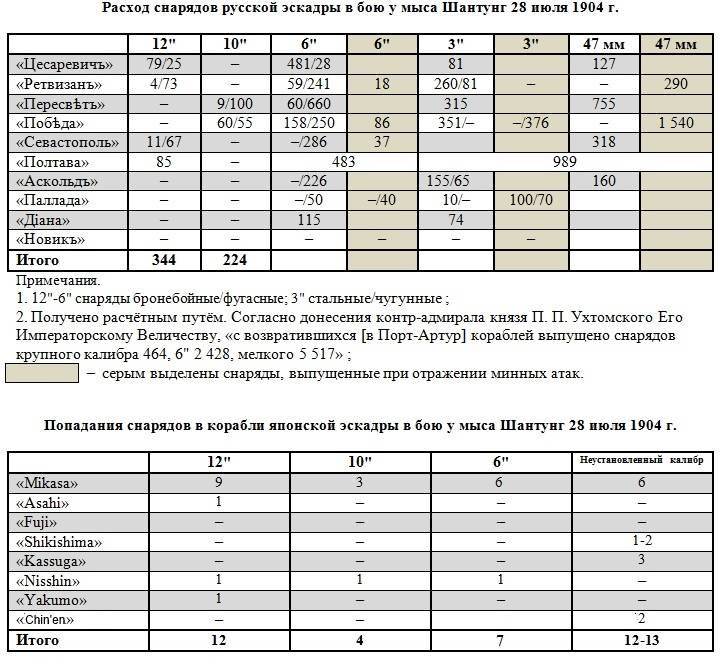
Total Russian battleships spent 568 large-caliber projectiles and 3 097 caliber 152-mm (not counting those that were spent on reflection of mine-bearing attacks, since it does not show hit statistics). As we can see, 12-13 shells of unknown caliber have fallen into the Japanese ships (assuming that they were 13 - this will benefit the average caliber artillery in our calculations). We will deal with them in the same way as in the case of determining the percentage of hits of the Japanese squadron - that is, we will attribute all these hits to the account of the average caliber (in our case, six-inch) artillery. Then the percentage of hits will look like:
For shells caliber 254-305-mm - 2,82%;
For shells, caliber 152-mm - 0,64%.
So, the accuracy of the Russian six-inch was 4,36 times worse than heavy cannons and for one hit 254-305-mm shells had only 1,25 hits 152-mm. And this, again, is the maximum, because we recorded all 13 shells of an “unidentified” caliber into six-inch hits!
And now we will try to go to the Tsushima battle. The generally accepted numbers of missile expenditure of the 1 and Japanese 2 units are as follows:
305-mm - 446 pcs .;
254-mm - 50 pcs .;
203-mm - 1 199 pcs. (284 - "Nissin" and "Kasuga", 915 - Kamimura's cruisers, excluding the battle with "Admiral Ushakov");
152-mm - 9 464 pcs. (including 5 748 shells from the 1-th combat detachment and 3 716 shells from the cruisers of the 2-th Kamimura squad, but also excluding the shells expended in Admiral Ushakov);
In total, in the Tsushima battle, the 1-th and 2-th combat units used 496 large-caliber (254-305-mm) and 10 663 medium-caliber (152-203-mm) missiles. In other words, the Japanese used a medium-caliber 21,49 projectile for one large-caliber missile. Why has this ratio increased relative to January 27 and 28 July fights 1904 r?
First of all, because 27 of Japanese battleships and 6 armored cruisers took part in the 4 battle of January, 28-th battle squadron (1 battleship and 4 armored cruisers) fought for the third cruiser, which the third cruiser (Yakumo) fought in July, to which the third cruiser (2 battleship and 2 armored cruisers) fought. only in the 4 phase, and the participation of "Asama" was completely episodic. Thus, in both cases, the number of battleships participating in the battle exceeded the number of armored cruisers. At the same time, battleships 8 and XNUMX armored cruisers of the Japanese fought in the Tsushima battle, that is, the ratio of the number of large-caliber and medium-caliber artillery barrels increased significantly in favor of the latter.
Suppose also that in Tsushima the Japanese ships demonstrated the best accuracy of those achieved earlier, that is, the percentage of hits of 254-305-mm shells reached 10,22% (as in a battle in the Yellow Sea), and for shells of 152-203-mm - 1,95%, ( as in January 27 battle). In this case, the Japanese have achieved 51 hits with large-caliber projectiles (rounded up) and 208 - medium caliber. In this case, the number of hits of medium-caliber shells per one large-caliber will be 4,08 pcs.
Of course, it may well be that the Japanese in Tsushima shot more precisely - maybe on 20, and maybe on 30%, who knows? Suppose the Japanese shot at 25% more accurately, so their hit percentage was 12,78% and 2,44%, respectively. In this case, 64 large-caliber and 260 medium-caliber shells hit Russian ships (again, rounding up fractional values). But this does not affect the ratio between hits of large-caliber and medium-caliber shells - 254 units will be needed for one hit with 305-4,06-mm caliber. 152-203-mm projectiles - that is almost the same value, the difference is only due to rounding.
We see that the relationship of percentages of hits in the battles of January 27 and July 28 1904 r in the Japanese fleet did not change significantly. In the first case, Japanese commanders of medium-caliber artillery fired 5,19 times as bad as their counterparts operating heavy cannons (1,95% and 10,13%, respectively), in the second case - 5,74 times (1,78% and 10,22%). Accordingly, there is no reason to assume that this attitude has changed dramatically in the Tsushima battle.
Thus, we conclude that if in a battle in the Yellow Sea Russian ships received 254-305-mm projectiles with 1,28-152-mm caliber for every hit of the 203-mm projectile, in 27 in January they were 2,75, and at Tsushima, probably already 4,1. This ratio is much more (3,2 times!) Than in the battle at Shantung, so it’s not surprising that Vladimir Ivanovich Semenov, who participated in both fights, perceived the Japanese fire in Tsushima as a hail of shells, which was not in the battle 28 in July 1904 Although one cannot exclude a purely psychological aspect - in the battle of July 28 V.I. Semenov was on the Diana armored cruiser, while the enemy, of course, concentrated the main fire on the battleships of the first Pacific squadron. At the same time, in Tsushima this, in every respect, a worthy officer was on the flagship battleship Suvorov, which was subjected to the most intense shelling. It is clear that when they fire at your ship, the enemy’s fire may seem more intense than when you watch the shelling of another ship from the side.
But back to the effectiveness of the fire of Japanese armored ships. Our calculations have led to the fact that the Russian ships fell from the force 210-260 shells caliber 152-203-mm. Is it a lot or a little? Even simply dividing the given number of hits on 5 of the most modern Russian battleships (4 of the Borodino and Oslyabyu types), we get the 42-52 hitting the ship maximum. Most likely, taking into account hits to other ships, there were no more than 40-45. Thus, the first thing that you can pay attention to is that the number of hits by medium-caliber Japanese artillery in Russian ships was large, but not excessive, hundreds of shells are out of the question - in the worst case, up to fifty. Could such a number of hits cause significant damage to our battleships?
Given what we know about the effectiveness of artillery caliber 152-203-mm - quite doubtful. For example, in the same Tsushima battle, the Aurora armored cruiser received 18 order or even 21 hits, but was not seriously injured and did not fall out of action. The same can be said about “Pearls”, which received 17 hits (including small-caliber). True, the Svetlana armored cruiser was sunk by mid-caliber artillery, but this is a ship with a displacement of less than 4 000 t.
In the battle in the Korean Strait, when three Russian ships fought with four armored cruisers Kamimura, the “Russia” and “The Thunderbolt” received 30-35-mm shells each with 152-203. It must be said that armor had only armor protection of Artillery, but even in Russia most of the guns failed not because of the impact of enemy projectiles, but because of breaks in the lifting arches, that is, a constructive defect in the machines. For the rest, despite the defeat of unarmoured parts and pipes, both cruisers did not receive particularly heavy damage, and in fact their protection was much more modest than even the relatively weakly armored Oslyab.
A detailed analysis of the damage received by the Peresvet squadron battleship in a battle in the Yellow Sea shows that 22 hits with 152-203-mm caliber (this includes also projectiles of unknown caliber, which most likely were 152-mm) did not cause the ship how many Serious damage (except for numerous damage to 75-mm guns). The same can be said about 17 "medium caliber" hits in "Retvizan", he received in the same battle.
According to some reports, the shell, whose debris damaged the centralized fire control system on the battleship Orel, was eight inches. According to the available descriptions, three six-inch shells fell into the conning tower of the ship, but did not cause any harm, and then an 203-mm projectile ricocheted from the sea surface, which caused the above damage, hit it. On the other hand, the descriptions of the damage to the Eagle have become the object of so many speculations that it is absolutely impossible to guarantee the truth of the above.
The First World War also did not demonstrate the special power of artillery with 152-203-mm caliber in cases when high-explosive shells were used. Thus, the famous German corsair, the cruiser Emden, with a normal displacement of 3 664 t, in its last battle received about 50 152-mm high-explosive shells and, although it was completely disabled, but still did not sink (the ship dropped on the stones) . The British light cruiser Chester suffered significant damage from 17 150-mm high-explosive German shells fired at it from a distance of 30 cables and less, lost 30% of its artillery, the fire control system was put out of action - but it is still a question of a weakly armored 5 185 tons of displacement. The very small Albatross, with a total displacement of about 2,2 thousand tons received over 20 152-203 mm Russian missiles hits and, of course, completely lost its combat capability, but was able to reach the Swedish coast and was thrown onto the stones.
Perhaps the only undoubted success of medium-caliber artillery was the destruction of British armored cruisers Good Hope and Monmouth by M. Spee’s squadron in the battle of Coronel, but there the Germans used high-explosive and armor-piercing projectiles in approximately equal proportions, even though 666 used 210 -mm armor-piercing shells were 478, but from 413 152-mm shells armor-piercing were only 67.
But back to the Tsushima battle. As we said earlier, we do not know either the number of hits to the dead battleships, nor the damage caused by them, except, perhaps, the Oslyabya battleship, about which there are evidences of eyewitnesses who served on it. It is also known that medium-caliber artillery cannot claim the destruction of a single heavy Russian ship. "Suvorov", despite the hardest damage, was sunk by torpedoes. "Alexander III", according to eyewitnesses, had a very large hole in the bow of the body. Apparently, as a result of hits of enemy shells, armor plates turned out to be either dented into the hull, or split, and perhaps even fell off of him - an analysis of the damage to the ships of the Russian-Japanese war shows that only 305-mm were capable of such a "feat" shells. As far as can be judged, it was this hole that ultimately led to the death of the ship, as the ship tilted during the turn, and the open ports of the 75-mm gun battery went under water, causing the flooding to take on an avalanche-like character and the ship turned over. The squadron battleship Borodino exploded after hitting an 305-mm projectile from the battleship Fuji. A key role in the death of "Oslyab" was played by hit of an 305-mm projectile in the nose of the ship, in the waterline area under the nose tower, which caused extensive flooding ...
Incidentally, Oslyabya is probably one of the three armored ships, in whose death Japanese middle caliber artillery played a significant role. The fact is that when the ship sat down with its nose, according to survival memories, the struggle for survivability was greatly complicated by the large number of holes through which water flowed, and which resulted from the “work” of artillery in 152-203-mm caliber. But "Dmitry Donskoy" really received critical damage from mid caliber artillery fire. But, firstly, we are talking about a completely outdated “armored frigate”, and secondly, even he, taking part in the Tsushima battle, defended transports, helped “Oleg” and “Aurora” to repel the attacks, where as many cruisers Uriu, then he fought with as many as six enemy armored cruisers, and the latter could not win over him and fell behind. And only the coastal defense battleship "Admiral Ushakov" was a more or less modern ship, killed by mid caliber artillery fire, whose penetration into unarmored parts of the hull caused extensive flooding, inclination and, as a result, inability to fight.
What is the conclusion?
Without a doubt, in theory, hitting six- and eight-inch shells could, with luck, inflict damage to our battleships, to a certain extent, reducing their combat capability. However, we have no practical confirmation of this thesis. All hits in the Russian squadron battleships shells caliber 152-203 mm, the consequences of which we are reliably known, did not cause them significant damage. At the same time, there is reason to believe that in Tsushima, approximately twice as many shells hit the ship in Tsushima than in the same battle in the Yellow Sea. Accordingly, we can assume that some of them could still inflict significant damage on the battleships of the 2 Pacific Pacific Squadron. But at the same time, we have no single reason to believe that it was the “hail of six- and eight-inch shells” that led to the fatal fall in the combat capability of the best ships of ZP Rozhdestvensky - squadron battleships like "Borodino" and "Oslyab", that is, decided the fate of the battle.
On the whole, analysis of Russian-Japanese and World War I war clashes suggests that 152-203-mm rounds were relatively effective in causing heavy, and in some cases decisive, damage only to poorly protected warships with displacement up to 5 000.
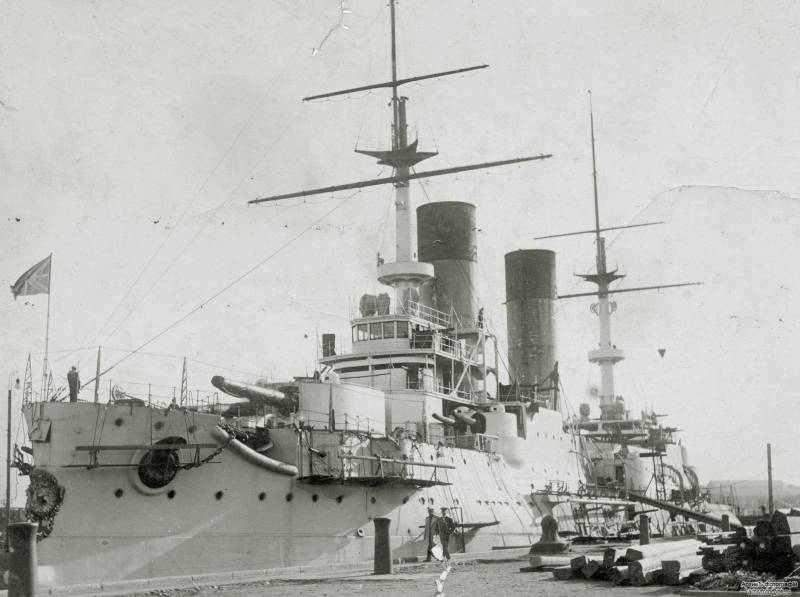
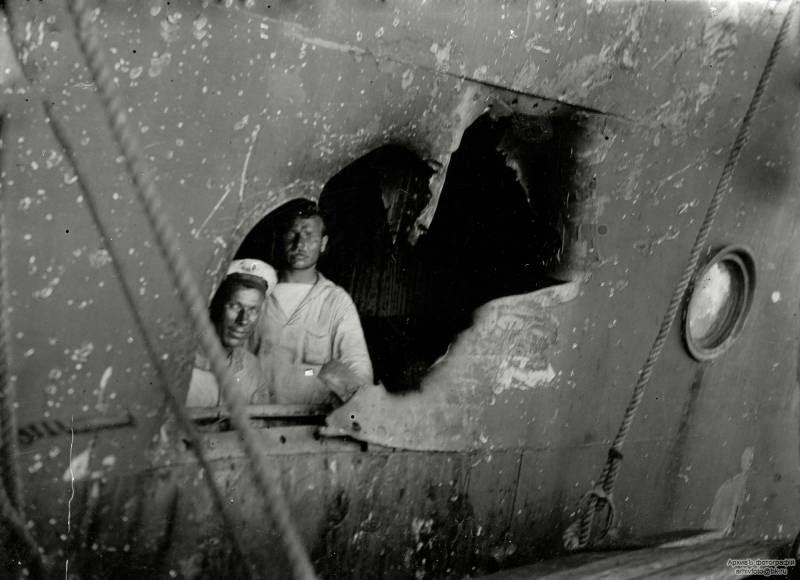

Information